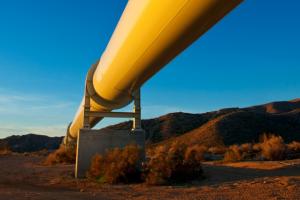Increasing the use of natural gas is one of the actions suggested to reduce the carbon intensity of energy systems, mainly because it can sustain growing energy needs with lower carbon emissions compared to other fossil fuels. As the quick-ramping ability of natural gas makes it an effective complement to variable renewable energies, such as wind and solar, it is also argued that natural gas represents a bridge fuel for shifting away from coal and oil while still allowing other low-carbon energy options to expand.
However, in contrast to other fossil fuels, the concentration of natural gas in a small number of exporting countries had been one of the most important hurdles to expanding its use, in spite of the growth of liquefied natural gas (LNG) trade.
This situation drastically changed with the commercial production of shale gas in the United States. The rapid pace of production boosted the country’s natural gas supply and strengthened United States energy self-sufficiency leading to a significant displacement of coal for power generation as well as the advent of LNG exports. Moreover, prospected shale gas resources suggested that this success could be replicated across the world, as their magnitudes are much larger and better distributed.
It is in this context that the large-scale development of shale gas has been advocated by many analysts and professionals in the natural gas industry as an effective path to energy transition, largely based on the United States experience. In practice, however, commercial development outside of the United States is limited to a few other countries where the modest magnitudes of production and the high risks created, particularly to the environment, so far greatly limit the promise of bringing about net economic benefits. Even in that country, significant environmental and social challenges call into question the massive development of shale gas and its role in advancing an effective transition to low-emissions energy systems.
Shale gas development across the world: A flash in the pan?
Despite the international attention given to shale gas in a number of countries interested in developing this type of gas resource, the challenges presented have often led to lowered expectations. Countries like France and Germany, as well as specific states and provinces such as the Quebec province in Canada or even the State of New York in the United States have banned the extraction activities for shale gas development due to the risks identified. By the end of 2015, shale gas was only produced on a commercial basis in Argentina, Australia, Canada, and China, and is still far from the levels seen in the United States in terms of pace and magnitude of production.
Compared to conventional gas production, shale gas development poses more risks, some of which are cumulative and not yet fully recognized due to the profile and intensity of the extraction activities involved, most noticeably hydraulic fracturing, commonly known as “fracking”. Some of these risks include:
- Issues concerning the use and pollution of water supplies, including those used for human consumption,
- Methane emissions, which have a more negative impact on the atmosphere than carbon dioxide;
- Induced seismicity;
- Occupational and public health issues;
- Impacts to community life, including increased road traffic, noise and dust.
Shale gas in the United States: Net benefits for whom?
Fundamentally, shale gas development not only poses risks that span a wider array of dimensions than conventional gas, but these risks are also perceived differently by the diverse stakeholders involved, adding to the complexity of the production process. Despite the international attention that shale gas development attracted, major environmental and social problems call into question its long-term viability, even in the United States.
Moreover, while the private ownership of petroleum rights unique to the United States is largely credited as one of the most important factors underpinning its booming shale gas production, landowners do not necessarily own the petroleum rights for their property, as the split estate severs the ownership of the surface rights from the subsurface rights. Therefore, many landowners in this situation do not receive any direct economic benefit but do endure all the associated impacts.
Even in a state like Texas with a long record of oil and gas activities, shale gas development is causing significant challenges for local communities, the industry, and the governments at different administrative levels. Elizabeth Riebschlaeger, a retired nun advocating against the risks of unsafe shale gas operations, and a group of citizens from Nordheim, Texas, a small community in the Eagle Ford Shale, believe that many local communities are not benefiting from shale gas development, and, in fact, the quality of life and the environment in their communities has been adversely affected, particularly due to the flaring of gas and unsafe disposal of hazardous waste at shale gas wells.
Scholars have noted that due to the asymmetrical benefits and risks shale gas development creates for the stakeholders involved, certain major “narratives” evolve with the aim of framing this activity under different—and often antagonistic—views of its associated benefits and risks.
On one side, an industry and government-supported narrative depicts shale gas development as a “game changer” bringing about energy security benefits, carbon emissions reductions, and economic spillovers. On the other side, civil society organizations, local communities, and the renewable energy industry promote the view that shale gas is an environmental threat with little, if any, benefit for an effective energy transition, which may preclude renewable energy development.
This situation is well illustrated by the first-hand experience gained by authorities and activists in Denton, Texas. In November 2014, the Denton City Council approved a landmark municipal ban on hydraulic fracturing, , which triggered legal and political action by the oil and gas industry. The ban was overturned within weeks of its passing. City Council authorities explained that the major problem leading to this ban was concerns over conflicts with other land-use practices, as the drilling, hydraulic fracturing, and flaring operations associated with shale gas development had been carried out in close proximity to areas such as houses, schools, and playgrounds. While the municipal ban was aimed at setting reasonable limits to these practices, its rejection instead became a symbol of the limits of local citizens’ ability to control energy activities and their environmental and social impacts.
Conclusion
Shale gas has been largely publicized as a “game-changer” that has helped the United States to be more self-sufficient in its production of natural gas and reap important economic benefits. Nevertheless, as production advances in many US states amid serious social and environmental issues, it is unclear at this point whether shale gas truly represents a fuel that can underpin a much-needed and long-awaited global transition toward cleaner energy systems.
Even though the United States is widely cited as an example of the positive benefits of undertaking the commercial production of shale gas, the risks derived from this activity on a massive scale seem to outweigh many of its heralded benefits. While natural gas produced from shale formations may produce significant environmental benefits by displacing coal-based electricity generation, it is also associated with significant environmental impacts, and it may limit opportunities for an energy transition to expanded renewable energy. Moreover, while the private ownership of oil and gas has been so instrumental to the success of shale gas development in the United States, due to the split estate many of the touted economic benefits never reach the affected citizens. In fact, experience shows that under the US shale gas boom, the profits of concentrated economic interests have often been prioritized over environmental conservation and sound community life.
Due to these cumulative challenges, efforts to commercially develop shale gas beyond the United States have seen only modest success thus far, expanding to only a small number of other countries. Additionally, the prospect of permanently low oil and gas prices could further weaken the economic rationale to push forward this development. All these elements raise the question as to whether shale gas can play a key role in the global energy transition. At least for now, the answer seems highly questionable.
Juan Roberto Lozano-Maya is an Emerging Leaders in Environmental and Energy Policy (ELEEP) fellow with the Atlantic Council and Ecologic Institute.
*This article initially appeared on the Atlantic Council's New Atlanticist Blog.
Photo: Fotolia






